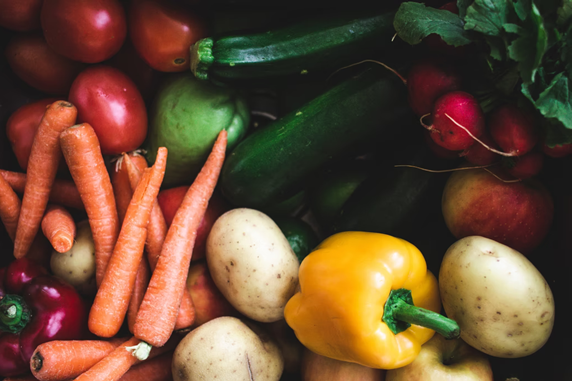3.4: Concerns for Underconsumption and Overconsumption
- Page ID
- 139637
Over and Under Consumption
In the United States, some dietary components are of public health concern for infants and toddlers. Iron is a dietary component of concern among older infants ages 6 through 11 months who are fed primarily breast milk and consume inadequate iron from complementary foods. Older infants who are fed primarily breast milk also under-consume zinc and protein from complementary foods, and vitamin D, choline, and potassium are notably under-consumed by all older infants. During the second year of life, the dietary components of public health concern for underconsumption are vitamin D, fiber, and potassium and concern for overconsumption include added sugars and sodium. [1]
Introduce Iron-rich Foods Starting at about Six Months
Iron-rich foods are important components of the infant’s diet from age 6 through 11 months to maintain adequate iron status, which supports brain development and immune function. Infants are typically born with body stores of iron adequate for about the first 6 months of life, depending on gestational age, maternal iron status, and timing of umbilical cord clamping. By age 6 months, however, infants require an external source of iron apart from breast milk. [1]
A complementary food source of iron beginning at about 6 months is particularly important for infants fed breast milk because the iron content of breast milk is low and maternal iron intake during lactation does not increase its iron content. In the United States, an estimated 77% of infants fed breast milk have inadequate iron intake during the second half of infancy, highlighting the importance of introducing iron-rich foods starting at age 6 months. [1]
Infants receiving most of their milk feeds as iron fortified infant formula are likely to need less iron from complementary foods beginning at 6 months of age. After age 12 months, children have a lower iron requirement, but good food sources of iron are still needed to maintain adequate iron status and prevent deficiency. [1]
Iron found in foods comes in two forms: heme and non-heme iron. Heme iron is commonly found in animal products and is more easily absorbed by the body. Sources of heme iron include: [2]
- Red meat (for example, beef, pork, lamb, goat, or venison)
- Seafood (for example, fatty fish)
- Poultry (for example, chicken or turkey)
- Eggs
Non-heme iron can be found in plants and iron-fortified products. This type of iron is less easily absorbed by the body and will require careful planning to get enough iron for your baby. Sources of non-heme iron include: [2]
- Iron-fortified infant cereals
- Tofu
- Beans and lentils
- Dark green leafy vegetables
Pairing non-heme iron sources with foods high in vitamin C can help with iron absorption. Vitamin C-rich fruits and vegetables include: [2]
- Citrus fruits like oranges
- Berries
- Papaya
- Tomatoes
- Sweet potatoes
- Broccoli
- Cabbage
- Dark green leafy vegetables

Introduce Zinc-rich Foods Starting at about Six Months
Zinc-rich complementary foods are important from age 6 months onwards for adequate zinc status, which supports growth and immune function. Although the zinc content of breast milk is initially high and efficiently absorbed, the concentration declines over the first 6 months of lactation and is not affected by maternal zinc intake. During the second half of infancy, approximately half (54%) of U.S. infants fed breast milk have inadequate zinc intake. Prioritizing zinc-rich foods starting at 6 months of age to complement breast milk feedings can help infants meet their requirement for zinc. [1]
Encourage a Variety of Food
To support nutrient adequacy, foster acceptance of healthy foods, and set intakes on a path toward a healthy pattern, it is important to encourage foods from all food groups. Because very young children are being exposed to new textures and flavors for the first time, it may take
up to 8 to 10 exposures for an infant to accept a new type of food. Repeated offering of foods such as fruits and vegetables increases the likelihood of an infant accepting them (Nicklaus, 2016). Several studies have shown that a food is consumed more and is judged as more liked by the infant after several offerings. For example, an increase in acceptance of a new green vegetable was observed after 10 exposures (Sullivan & Birch, 1994), and an increase in intake of a new fruit or vegetable was shown after eight exposures (Birch, Gunder, Grimm-Thomas & Laing, 1998). The effect of repeated exposure is great enough to increase the acceptance of foods which had been previously identified by the mother as being refused by her infant, which were most often green vegetables and pumpkin (Maier et al., 2007). However, despite the documented success after multiple offerings, foods are most often only presented a limited number of times (often less than five times) before the parent(s) decide that the infant dislikes this food (Carruth, Ziegler, Gordon & Barr, 2004). [1] [3]
A nutrient-dense, diverse diet from 6 months through toddlerhood includes a variety of food sources from each food group. Protein foods, including meats, poultry, eggs, seafood, nuts, seeds, and soy products, are important sources of iron, zinc, protein, choline, and long chain polyunsaturated fatty acids. The long-chain polyunsaturated fatty acids, specifically the essential omega-3 and omega-6 fatty acids supplied through seafood, nuts, seeds, and oils, influence the infant’s fatty acid status and are among the key nutrients needed for the rapid brain development that occurs through the infant’s first 2 years of life. Some types of fish such as salmon and trout are also natural sources of vitamin D. [4]

Vegetables and fruits, especially those rich in potassium, vitamin A, and vitamin C, should be offered to infants and toddlers starting at age 6 through toddlerhood. The vegetable subgroup of beans, peas, and lentils also provides a good source of protein and dietary fiber. [1]
For dairy, families can introduce yogurt and cheese, including soy-based yogurt, before 12 months. However, infants should not consume cow milk, as a beverage, or fortified soy beverage, before 12 months as a replacement for breast milk or infant formula. In the second year of life, when calcium requirements increase, dairy products, including milk, yogurt, cheese, and fortified soy beverages and soy yogurt provide a good source of calcium. Vitamin D-fortified milk and soy beverages also provide a good source of vitamin D. For those younger than the age of 2, offer dairy products without added sugar. [1]
Grains, including iron-fortified infant cereal, play an important role in meeting nutrient needs during this life stage. Infant cereals fortified with iron include oat, barley, multigrain, and rice cereals. Rice cereal fortified with iron is a good source of nutrients for infants, but rice cereal shouldn’t be the only type of cereal given to infants. Offering young children whole grains more frequently than refined grains will increase dietary fiber as well as potassium intake during the second year of life and help young children establish healthy dietary practices. [1]
Dietary Components to Limit
While encouraging intake from each food group, some dietary components should be limited. Infants and young children have virtually no room in their diet for added sugars. This is because the nutrient requirements for infants and young children are quite high relative to their size, but the amount of complementary foods they consume is small. Complementary foods need to be nutrient-dense and not contain additional calories from added sugars. In addition, low- and no-calorie sweeteners are not recommended for children younger than age two. Taste preferences are being formed during this time period, and infants and young children may develop preferences for overly sweet foods if introduced to very sweet foods during this timeframe. [1]

Sodium is found in a number of foods, including some salty snacks, commercial toddler foods, and processed meats. In addition to keeping sodium intake within limits for toddlers, another reason to avoid high-sodium foods is that taste preferences for salty food may be established early in life. Choose fresh or low-sodium frozen foods, when available, and low-sodium canned foods to minimize sodium content. [1]
Infants should not be given any foods containing raw or cooked honey. Honey can contain the Clostridium botulinum organism that could cause serious illness or death among infants. Infants and young children also should not be given any unpasteurized foods or beverages, such as unpasteurized juices, milk, yogurt, or cheeses, as they could contain harmful bacteria. [1]
Due to the relatively high nutrient needs of toddlers, a healthy dietary pattern has virtually no room for added sugars. Toddlers consume an average of more than 100 calories from added sugars each day, ranging from 40 to 250 calories a day (about 2.5 to 16 teaspoons). Sugar-sweetened beverages, particularly fruit drinks, contribute more than 25 percent of total added sugars intakes and sweet bakery products contribute about 15 percent. Other food category sources contribute a smaller proportion of total added sugars on their own, but the wide variety of sources, which include yogurts, ready-to-eat cereals, candy, fruits, flavored milk, milk substitutes, baby food products, and breads, points to the need to make careful choices across all foods. [1]
[1] “Dietary Guidelines for Americans, 2020-2025” by U.S. Department of Agriculture and U.S. Department of Health and Human Services is in the public domain.
[2] “Iron” from the CDC is in the public domain
[3] Image by Stewardesign on Pixabay.
[4] Nicklaus (2016). Complementary feeding strategies to facilitate acceptance of fruits and vegetables: A narrative review of the literature. International Journal of Environmental Research and Public Health, 13(11), 1160. CC by 4.0
[5] Image by Marisol Benitez on Unsplash.
[6] Image by Henley Design Studio on Unsplash.

